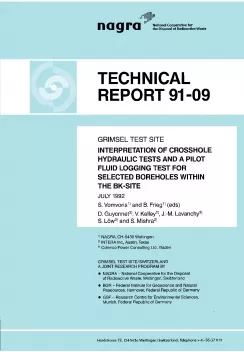
Technical Report NTB 91-09
Grimsel Test SiteInterpretation of crosshole hydraulic tests and a pilot fluid logging test for selected boreholes within the BK-site
This report presents the analysis of hydraulic tests performed by the Bundesanstalt für Geowissenschaft und Rohstoffe (BGR) and of a pilot crosshole fluid logging test performed by NAGRA/COLENCO, in the fractured crystalline rock of the BK area in the Grimsel Test Site (GTS).
The hydraulic tests were single-and crosshole constant-head injection tests into borehole 85.004. The test analysis philosophy is based on the use of diagnostic plots. These plots provide indications relative to the flow model and to the presence of boundaries. Results of the single-hole analysis indicate a mixed response with an early-time portion dominated by radial flow followed by a later-time portion showing linear or bounded-flow characteristics. Analysis of the observation interval response shows evidence of a highly transmissive feature and confirms the presence of low permeability boundaries indicated by the single-hole analysis.
For the pilot crosshole fluid logging test, a salt brine was injected into borehole 85.004 and electrical conductivity and temperature logs were measured in various boreholes of the BK area. The test successfully identified flowing fractures in observation boreholes which were (1) connected to the injection borehole or (2) apparently not connected to the injection borehole. A large amount of information relative to flowing fracture locations (53 individual fractures) was obtained in a relatively short period of time (9 days of testing). The method of Partial Moments was used to calculate interval flow rates and, despite non-optimal conditions for application of this methodology, provided interval flow rates for each borehole which added up to values in good agreement with measured total borehole flow rates. The BORE finite-difference model was used to simulate the measured conductivity logs and provided estimates of fracture flow rates as well as fracture inflowing fluid concentrations. The locations of the fractures with the highest inflowing fluid concentrations (and therefore supposedly those best connected to the injection interval), correspond to the locations of the intervals which intersect a highly transmissive feature as shown by the hydraulic tests.
